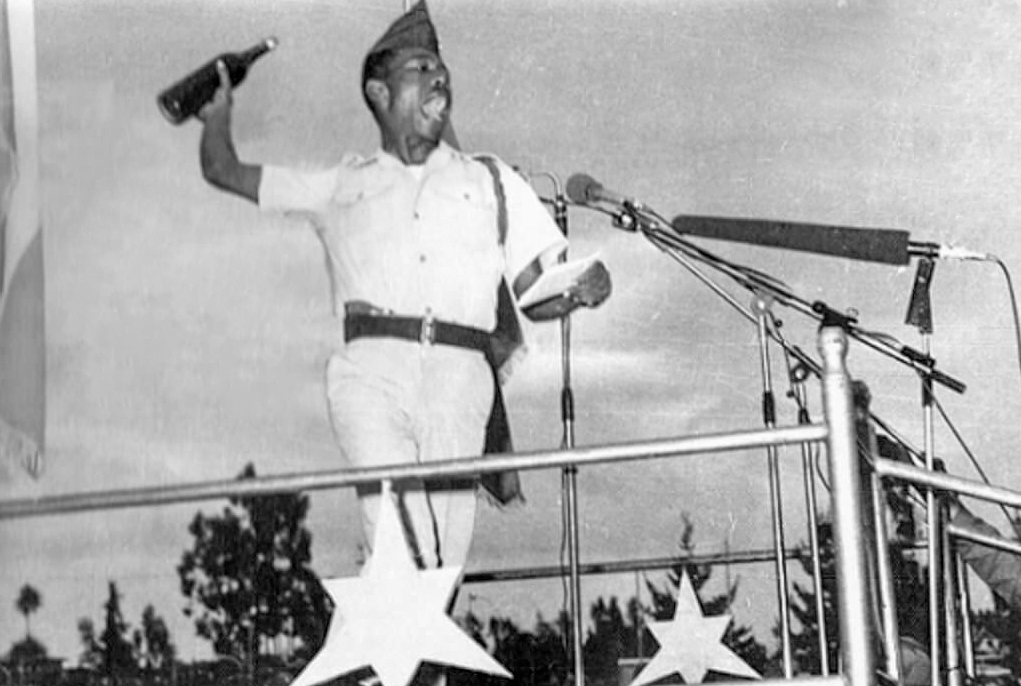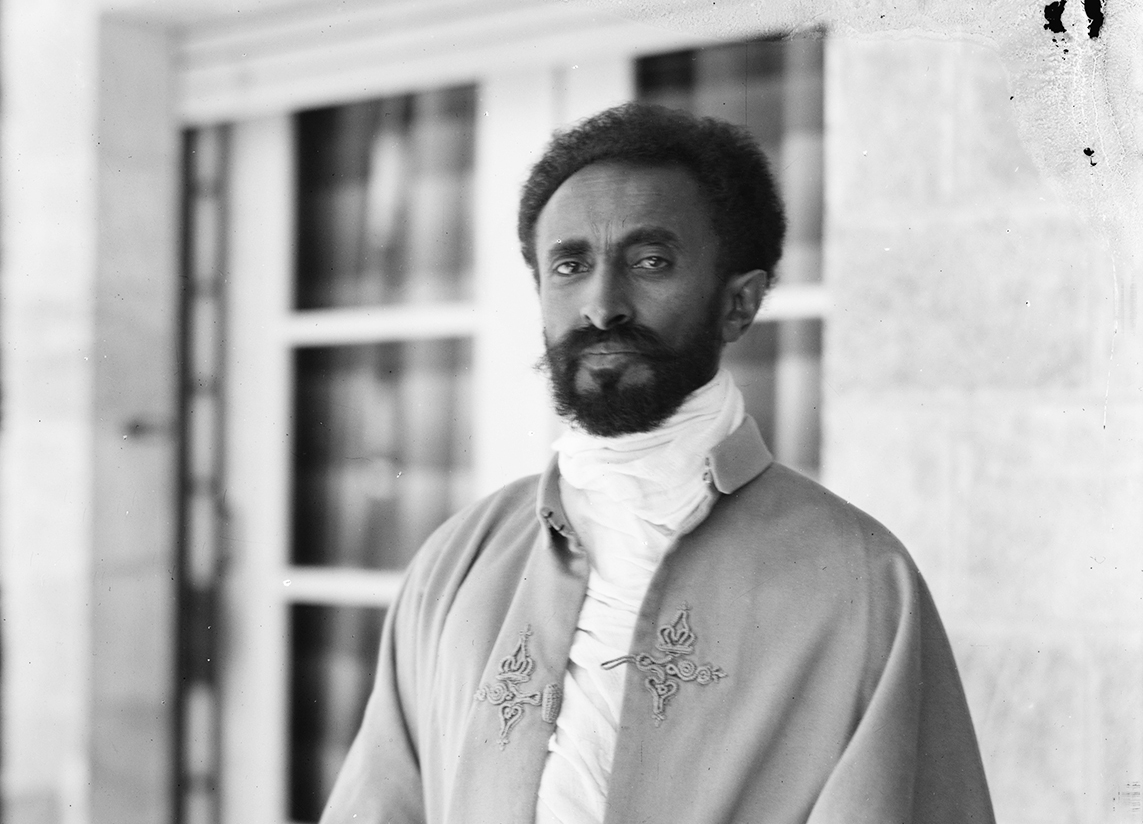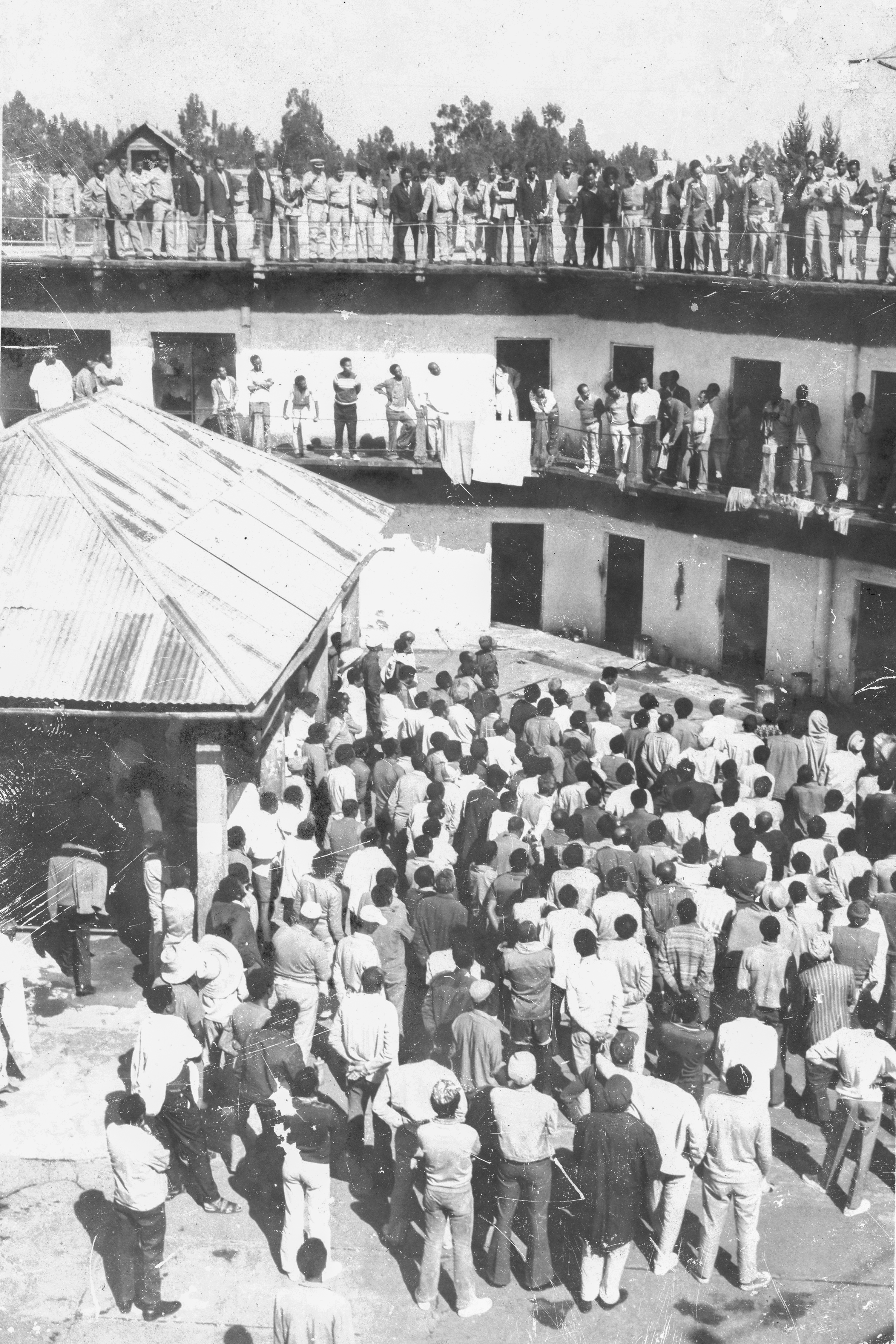The trial of Mengistu Haile Mariam and the genocide in Ethiopia. Part 1. The prosecution of crimes
In this two-part article, Dr. Firew Tiba analyses the trials of Mengistu Haile Mariam and other members of the Derg, the Marxist-Leninist military junta that ruled Ethiopia for seventeen years from 1974 until 1987 for the crimes they committed in this period. The trial, which began in 1995 and brought an entire regime before a national court, was the first of its kind in Africa. After a twelve-year trial, Mengistu and his co-accused were found guilty of genocide and crimes against humanity in 2006, making this one of the longest genocide trials ever.
Part 1 describes what happened in those years under Mengistu’s reign and the ultimate decision to prosecute Mengistu and other members of the Derg.
Part 2, to be published at later date, analyses the trials of Mengistu and the senior Derg officials.

The 1976 Revolution
The 1976 Ethiopian popular revolution brought an end to one of the longest monarchies in the world. The group of junior officers called the Derg, who spearheaded the overthrow of the monarchy also took the path of socialism largely persuaded by the student and intellectual movement of the day which favoured the socialist mode of governance for a country emerging from feudalism. While the revolution was initiated by university students, peasants, labour unions, urban dwellers, and intellectuals, the army joined the movement because it also had its administrative issues it sought to be addressed. This subsequently led to the formation of a mobilization committee that took charge of the negotiation with the emperor. The junior officers represented various army divisions across the country. However, the negotiations failed to break the deadlock.
Following this deadlock, the junior officers representing the army took matters into their own hands and dethroned the aging monarch and established the Provisional Military Administration Council (the Derg) on 28 June 1974. Then the Derg swiftly declared the abolition of the imperial regime.[1] In a decree that followed two days later, Proclamation No. 2/1967, the members of the Derg, numbering a little over 100, assumed the position of collective heads of states instead of giving power to one single individual. This arrangement changed sometime later when members resolved to empower the Chairman to implement decisions of the Derg’s general assembly, standing committee and sub-committees.
The first victims of Derg’s crimes were sixty officials of the imperial regime who were summarily executed and Derg’s members subjected to purges. The sixty officials that included the former long-time prime minister, ministers, army generals, aristocrats and nobility were killed by a decision of the Derg committee members. Emperor Haileselassie was killed in prison sometime later.
The power monopoly by the military was not acceptable to other political parties. These parties championed the establishment of a popular socialist government not controlled by the military. The ensuing political confrontation ushered in an era of terror, known as the Red Terror, that led to the death and injury of tens of thousands of people.[2] At the height of this confrontation, the Derg empowered its security apparatus, urban and rural dweller associations, militias, and revolutionary guards to kill, torture and maim with impunity anybody suspected of being a ‘subversive’, ‘anti-revolutionary’, ‘counter-revolutionary’, or ‘anti people’.[3]
The Red Terror was a campaign of urban counterinsurgency waged in the main cities of Ethiopia between 1976 and 1978 and has been characterized as ‘one of the most systematic uses of mass murder by the state ever witnessed in Africa’ at the time.[4] The official phase of the Red Terror (a reaction to what was described as the opposition forces’ White Terror) began on 17 April 1977 with Mengistu’s speech and the symbolic smashing of three bottles in a public square. The three bottles represented the blood of imperialism, feudalism, and bureaucratic capitalism.[5] This symbolic act of spilling blood was literally applied, with fervent zeal, in the coming years. The following excerpt from the Human Rights Watch report lays bare the brutality as follows:
Bodies were left on the roadside to advertise the killings of the previous night—those who inspected the piles of bodies to see if their friends or relatives were among the corpses were targeted for execution or imprisonment themselves. Relatives were forbidden to mourn. In other cases, relatives had to pay one Ethiopian dollar for each ‘wasted bullet’ in order to have the body returned.[6]
Even children were not spared the violence. As a Human Rights Watch report confirms (quoting Rene LeFort): ‘Simply knowing how to read and write and being aged about 20 or less were enough to define the potential or actual “counter-revolutionary”. The authorities were even able to institute a law authorizing the arrest of children between eight and twelve years.’[7]
While the state-sponsored violence targeted victims far and wide, the use of violence to achieve political objectives was not monopolized by the Derg. There were indeed several assassinations of those allied to the Derg by radical political groups. The Derg blamed radical opposition elements for firing the first shot, forcing it to respond in kind. Unfortunately, the Special Prosecutor’s mandate did not extend to the investigation of the conduct of forces other than the Derg during the Red Terror. This has had the effect of undermining the objectivity of the trial. In a sense, the trial tells one side of the story and fails to fairly apportion blame, which is critical to the healing process.
The decision to prosecute Mengistu and members of his regime
Following the overthrow of the Workers’ Party of Ethiopia (formerly Derg) in 1991, a policy decision was made by the Transitional Government of Ethiopia (TGE) to apprehend, investigate, and prosecute members of the Derg (both high- and low-ranking) for crimes committed by the regime and its loyalists. The law establishing the Special Prosecutor Office claimed that ‘heinous and horrendous criminal acts which occupy a special chapter in the history of the peoples of Ethiopia have been perpetrated against the people of Ethiopia by officials, members and auxiliaries of the security and armed forces of the Dergue-WPE regime’.[8]
However, the circumstances surrounding the decision to prosecute Mengistu Haile Mariam and his collaborators were not transparent—or at least the deliberations that took place surrounding that issue are not in the public domain. Also, it was not clear whether other modes of transitional justice were actively and genuinely discussed by the House of Representatives, the organ that served as a legislative arm of the TGE.
The sheer magnitude of the crimes and the multidimensional nature of the conflict throughout the period of the Derg’s reign made it impossible for the government to comprehensively document what took place, let alone bring all of the suspects to justice.
The serious crimes committed during the seventeen-year rule by the military are too many to be prosecuted in such a short period. The acts of killing and torture committed qualify as some of the most horrendous acts of savagery committed by men against men. The following lists demonstrate this savagery. The killings as revealed to Parliament by the Special Prosecutor are the following: executions; beatings with sticks; throwing people off cliffs; throwing people into rivers alive; strangling with a cord or nylon rope; injection of poison; electric shock; suffocation with an anesthetic agent and then strangulation (particularly used against the former Emperor Haileselassie).[9]

Forms of torture include: whipping with an electric cable or leather whip after binding the victim’s legs and hands and stuffing objects into their mouths; whipping while the victim is suspended; keeping a bound victim suspended for long time; torture by electric shock; applying a burning newspaper to the body; pulling out hair; mutilating the body; rubbing a dry body or bones with a wooden board; stretching nails and nipples with pincers; pulling out fingernails; killing or torturing others in the presence of the victim; frightening by setting dogs on a person; taking victim for a false execution; suspending heavy objects from men’s genitals; inserting heavy objects into a woman’s uterus; forcing a victim with wounded feet to walk on gravel; as well as other forms of torture not included here.[10]
Ethiopia’s choice of prosecution as a transitional justice model means that stories of the sad episode are mainly told through the official channels of court documents and witness testimonies in an adversarial setting. Yet adversarial court proceedings are not necessarily the best mechanisms for getting the true picture of events surrounding the crimes committed.
Prosecution of the suspects meant that grant of amnesty for the crime committed was not an option. As Tronvoll, Schaefer, and Aneme note, the TGE rejected amnesty in light of the country’s assumed responsibility under international human rights norms, whereby it is required to abrogate legislation leading to impunity for those responsible for grave violations of human rights and to seek prosecution of such violations.[11] However, the TGE carried out lustration and vetting measures that effectively blocked the political comeback of former officials.[12] The lustration was so comprehensive that it weeded out members of the defunct Workers Party of Ethiopia (WPE) from key administrative, judicial, military, and security positions. The vacant positions were restaffed from among the victors and those who had no ties to either the WPE or the Derg.
The major trial process had run its course, culminating in the decision of the Federal Supreme Court on 26 May 2008 that upheld the conviction of the accused by the High Court. In June 2011, the President of the Federal Democratic Republic of Ethiopia commuted the death sentence of 23 former officials convicted of genocide to that of a life sentence. Almost all of them have since been released from prison or have passed away. The last of the two Derg senior officials who took refugee in the Italian embassy also got their sentence commuted in 2020 after 22 years stay inside the embassy.[13]
The Special Prosecutor (SPO)
Having decided to prosecute Derg-era crimes, the Transitional Government of Ethiopia issued Proclamation 22/1992, establishing the Special Prosecutor Office (SPO).[14] The SPO was given the power to “conduct investigation and institute proceedings in respect of any person having committed or responsible for the commission of an offence by abusing his position in the party, the government or mass organization under the Derg-Workers Party of Ethiopia (WPE) regime.”[15]

Although the Special Prosecutor was established to prosecute the cases, once these were investigated, they were referred to regular courts. Certain divisions of the Central High Court (later renamed the Federal High Court) were assigned to try the cases. In addition, regional supreme courts were delegated to try crimes committed within their local jurisdiction. The designated regions were Tigray, Amhara, Oromiya, Southern Peoples Region, Harari, and Somali.[16] This is the first time in Ethiopian judicial history that judges tried such crimes of international ramifications, although the crimes charged—genocide and crimes against humanity—have been in the Ethiopian Penal Code since 1957.
The Special Prosecutor, Ato Girma Wakjira, who stayed on throughout the trial, was appointed by the President of the TGE upon the recommendation of the Prime Minister.[17] Under the Proclamation, the Special Prosecutor was made directly responsible to the Prime Minister and was not brought under the Minister of Justice, unlike regular prosecutors.
The Charges (Indictments)
The SPO filed with the Central High Court its first charges against 73 suspects in 1994, after two years of investigation. Of these, 21 were tried in absentia. The accused were classified into three major groups: 1) 146 policy and decision-makers; 2) 2,433 field commanders who transmitted orders from the first group or originated their orders; and 3) 2,619 simple perpetrators.[18]
Most, if not all, of the first 12 accused were politburo members of the Worker’s Party of Ethiopia (WPE) during its waning days and were among the original 120 Provisional Military Administration (Derg) members. They were charged with 211 acts of genocide, and alternatively 211 counts of homicide in the first degree and other offences against bodily integrity, including 1,823 killings, 999 bodily harm, and 194 enforced disappearances.[19] These top 12 accused were part of the first 73 suspects charged (seven died before the trial opened), which the SPO chose to join in the file Special Public Prosecutor v Mengistu Hailemariam & Others. Of the 66 accused who were alive when the charges were heard on 13 December 1994, 21 of them, including the Chairman of the Derg, Mengistu Haile Mariam himself, were not in custody leading to their trial in absentia. By the time the trial was concluded before the Federal High Court (13 years later), the number of accused was down to 57.[20]
The suspects were charged with genocide and crimes against humanity in violation of Article 281 of the 1957 Ethiopian Penal Code. The unusual nature of Article 281 of the Penal Code, which combined genocide and crimes against humanity, generated debates as to whether the SPO should have had recourse to customary international law and international human rights instruments in charges levelled against the accused.[21] The issue was further complicated by the Penal Code’s inclusion of “political groups” as additional groups protected against genocide.[22] The Genocide Convention extends protection only to “national, ethnical, racial or religious” groups.[23] Moreover, Ethiopia had in 1949 ratified the Genocide Convention, being one of the very first few countries to do so. The Ethiopian law on genocide will be examined in the next section.
List of sources.
[1] Provisional Military Government of Ethiopia, Proclamation No. 1/1967.
[2] Human Rights Watch, Ethiopia: Reckoning Under the Law , 6:11 (November 1994).
[3] Th e Red Terror was authorized by Proclamation 121 of 1977: see United States Institute of Peace (1994) Ethiopia: Report of the Office of the Special Prosecutor , < https://www.usip.org/sites/default/files/Ethiopia-SPODossier-2.pdf >
[4] Africa Watch (September 1991), ‘Evil Days: 30 Years of War and Famine in Ethiopia’, 101,
Human Rights Watch [website], < https://www.hrw.org/sites/default/files/reports/Ethiopia919.pdf >
[5] Ibid, 102.
[6] Ibid, 103.
[7] Ibid.
[8] Proclamation establishing the Office of the Special Prosecutor (8 August 1992), Proclamation No 22/1992, preamble, < http://www.usip.org/fi les/resources/Ethiopia-Charter.pdf >
[9] Firew Kebede Tiba, “Prosecuting International Crimes in Domestic Courts: The Trial of Mengistu and Other Derg Members for Genocide, Torture and Summary Executions” in Chacha Bhoke Murungu and Japhet Biegon (eds) Prosecuting International Crimes in Africa, Pretoria University Law Press, 2011, pp. 168-169.
[13] Ethiopian war criminals expected to leave Italian embassy after 29 years, 29 December 2020,https://www.irishtimes.com/news/world/africa/ethiopian-war-criminals-expected-to-leave-italian-embassy-after-29-years-1.4446546
[14] Proclamation 22/92, Negarit Gazeta, vol. 51, no. 18, 8 August 1992, Addis Ababa, Transitional Government of Ethiopia, 1992. For the establishment of the SPO, see Yacob Haile-Mariam, “The Quest for Justice and Reconciliation: The International Criminal Tribunal for Rwanda and the Ethiopian High Court,” Hastings International and Comparative Law Review, 22 (1989–1999), 667–745 at 689–92.
[15] Proclamation 22/92, Article 6.
[16] Out of a total of 5,198 accused charged by the SPO, 1,402 of them are being tried by regional supreme courts. The Harari Region Supreme Court started hearing on 5 February 1998 of eight cases against 198 former officials. The case from the Somali region, consisting of 174 accused, was transferred to the Harari Region for administrative reasons. The Supreme Court of Oromiya, based in Addis Ababa, started its hearing on 15 April 1998 against 855 accused on 15 cases of genocide and crimes against humanity. Likewise, the regional Supreme Court in Amhara region (based in Bahir Dar) began to hear of 17 cases against 508 accused on 29 May 1998. The regional Supreme Court in Tigray (based in Mekele) began trial in early June 1998 on two cases against 202 accused. For these and other crucial timelines, see Hanna Tsadik, Prosecuting the Past…Affecting the Future? A SIDA Minor Field Study of the Ethiopian Transitional Justice Trials (Uppsula: Department of Peace and Conflict Research, Uppsala University, 2007), 44–51.
[17] Proclamation 22/92, Articles 3 and 4.
[18] Todd Howland, “Learning to Make Proactive Human Rights Interventions Effective: The Carter Center and Ethiopia’s Office of the Special Prosecutor,” Wisconsin International Law Journal, 18 (2000), 407–35 at 426, footnote 51. On indictments in general, see Haile-Mariam, “The Quest for Justice and Reconciliation,” 708–12.
[19] Wondwossen L. Kidane, “The Ethiopian ‘Red Terror’ Trials,” in M. Cherif Bassiouni, ed., Post-Conflict Justice (Ardsley, NY: Transnational Publishers Inc., 2002), 682.